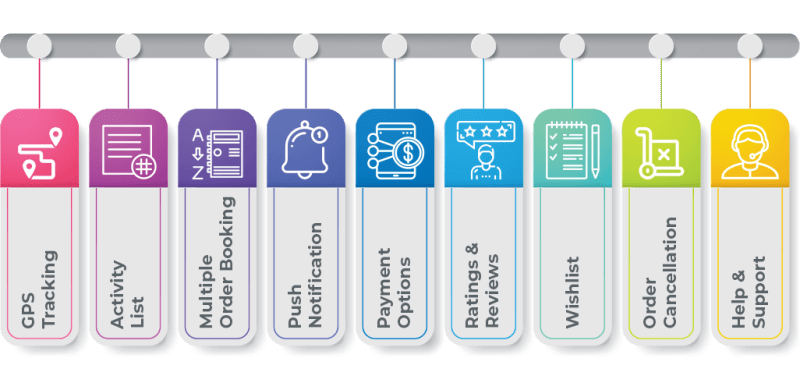The On-Demand business model is growing drastically and based on the Harvard Business Review, this line is attracting more than 22.4 million new customers and the spending in this area has reached $57.6 billion.
This clearly means that the market of On-Demand economy is booming and spreading with high speed. This means that whatever be the business you are into, it is important to have an startup business idea and how to start a on-demand business.
What is On-Demand Business Model?
On-Demand apps can be considered as a common ground or a platform which lets the businesses and consumers meet. The On-Demand apps cover a number of business sectors and it becomes easy for the consumers to get what they want in no time. In short, consumers can go ahead and purchase service or goods from the store seamlessly by following the secure payment options.
All that consumers have to do is make a few taps on their smartphones and there they are –done! Today several businesses are making use of such platforms to reach their target audience easily.
What are the Types of On-Demand Business Models?
| Type | Use | Examples |
|---|---|---|
| Customer to Customer (C2C) | Here a customer requests a service or a product from a person. | Uber, AirBnB, eBay, OLX |
| Business to Customer (B2C) | Here the customer can avail of the services or buy products from a business | Dominos, Starbucks, Nike,Amway |
| Business to Business (B2B) | These are the mobile platforms used to connect businesses. | Amazon, Flipkart, Walmart, UrbanClap |
Benefits of Uber for x business model App
Of Course – The App Customer First…
However the primary purpose of On-Demand uber for x services is to have a common place for customers and service providers. Different applications have been developed separately to make these two user groups work together. Apart from these two groups, there is also a group of gig or economy workers who are part of this arrangement. This group are independent and work on a part-time basis based on flexible working hours. They work as a middle layer between the customers and service providers. The major part of the on-demand service that they offer includes food delivery, transportation, and courier services.

Types of On-Demand Business Models
Based on the kind of services offered, you can separate the On-Demand business models into three types:
Customer to Customer (C2C)
Using this app model, people can easily exchange products or services. Whether you want to sell or buy a product or service from another person, you can do it here. Here no business entity is listed and buyer or seller is an individual person. This application is used by many to save money. Carpool services are one of such example.
A person can easily register himself or herself into an app like BlaBlaCar and look for co-travelers. The only needed thing is to enter the date of travel along with the starting point and arrival destination. On the other side, the rider who is looking for a ride will find the information good enough and will go ahead with it.
Business to Customer (B2C)
The B2C business apps are used to help have a smooth transaction between the providers and customers to move goods or services. Dominos, Starbucks, Nike, and Amway are some of the examples of the on-demand business app model.
Using such an application, the users can easily place orders online without having to stand in a long queue and get the product delivered at your doorstep.
Business to Business (B2B)
This kind of mobile app based business model is built to connect different businesses with each other. Such apps offer the facility to carry out transactions at the global level. Amazon, Flipkart, Walmart, and UrbanClap are some of the examples of on-demand apps with this business model. Here the users can easily avail of services from different businesses without having to look for the service provider in the vicinity.
Uber for X – Use Cases of On-Demand Apps 2023
In terms of local businesses, the On-Demand app can be considered as an new erra of mobile app development solution. Such an application proves to be helpful for new business and at its embryonic stage. and for the ones, which are already in the market but don’t have an application to move ahead.
Some of such on-demand app examples are:
On-Demand Food & Groceries Delivery App
Today you will not find anything new about the concept when it comes to getting meals and groceries delivered anytime and anywhere. Today we have a number of food delivery apps available in the market. Such apps are much beneficial for restaurants and customers. With such an arrangement the restaurants can get more orders and have them delivered efficiently while for the users, they get easy access to different menus at the comfort of their homes or offices and can have them whenever they want.
When it comes to the On-Demand delivery market, food delivery is considered as the most efficient one, which has made good results. There are on-demand grocery app too, which will let you have everything right from vegetables, fruits, dairy products to prepared foods – delivered at your doorstep.
Asia Pacific is also the growing region for this market and is anticipated to contribute revenue of USD 91.0 billion and share of 56.2% by 2023. – Source
On-Demand Home Services App
Just like any other on-demand app, the one for home services is quite popular too. Right from offering repair services to house cleaning, this application covers everything for the users. So whether you want to clean your house or paint it, build furniture or update your garden space, you can have them done in a single click. The service also includes finding a maid or domestic cook, elderly care support, etc.
On-Demand Transportation & Logistics App
There has been a lot of improvements made in On-Demand Logistics Services App. The popularity of uber for logistics services is due to real-time tracking, on-demand transportation, transparent pricing, easy and fast payments and in-app messaging services to connect with suppliers and customers.
On-Demand Medicine & Healthcare IT Solutions
On-Demand healthcare applications play a crucial role in connecting doctors and patients. Using such an application, users can easily have a direct connection with doctors anytime and from anywhere. Just like a regular doctor visit, the mobile apps can also be used for consultation were based on the diagnosis the doctor can make recommendations. such kind of apps can also do the work of delivering medicines to the patients at their doorstep based on the doctor prescription.
On-demand Taxi Services
The demand for on-demand cab services has increased a lot today. There are many reasons for the same like ease to find a cab, security, GPS and navigation system to let the drivers and users spot each other quickly, easy in-app communication between both parties and yes, feedback service which enables the user to and driver give ratings for the ride. The most famous name in this arena is Uber. You can also develop your own app like Uber and make your name in Taxi Services.
What are the Features of On-Demand Apps?

- GPS Tracking
- Push Notification
- Wishlist
- Activity List
- Payment Options
- Order Cancellation
- Multiple Order Booking
- Ratings & Reviews
- Help & Support
Key Challenges Faced by On-Demand Startups

The On-demand Business Model 2023
The On-Demand business is all about paying for the service of a person or for physical products. The decisions which are taken in terms of the business model plays a key role when it comes to influencing margins, demand and customer experience. Businesses can follow different models for success by opting for vertical integration or horizontal integration, go for C2C or have professionals hired; bundling or unbundling. Now they need to keep the net margin per transaction more compared to the demand if they want to get ahead of the costs of customer acquisition.
Regulations
When starting On-Demand business, startups should work towards implementing some regulations. Whether it is about maintaining safety in kitchens or following transportation regulations, they need to know what to follow and when.
Ready to Go On Demand Product Development
Startups always look for ways of how to start an on-demand business and build the right product. The On-Demand startups work towards bringing together everything in a manner that the final piece looks right.
When your startup is focused on delivering services, user experience plays a very crucial role. It is important to know the things that the in-house team can handle and what you need to get outsourced. Once you are clear about this, you will get a clear on-demand startup idea about how you can move your resources for carrying out important tasks like growth, operations, customer experience, etc.
Customer Experience
When we talk about user experience, there has been tremendous growth in terms of technology in the fields of mobile and web applications. However, when we speak about On-Demand services, much effort is needed to learn and perfect it. Whichever line or business you choose, only if you can offer unmatched customer experience, you will be appreciated and praised by the mass.
City Expansions
On-Demand companies bring on the table a new role in operations for the tech startups. Right from launching the business to taking care of supply operations, every company builds its own rules to manage things. Today more than just knowledge and science, the work of creating a profile for the launch, determining the rules and managing it has become more of art.
Growth
A large number of On-Demand app services currently is local, which means that they are limited geographically. This means opting for the standard marketing channels for growth is not going to do much good. Moreover, if you plan to go ahead with the mobile-first strategy, then you will not get many results from the efforts of SEO as your business is spread across the country. So the only means you have is to take it to the social media sites like Twitter or Facebook and attract local users for increased ROI.
Final thoughts
The service sector is growing rapidly and there is a cut-throat competition to stay ahead and deliver the best. Right from restaurants to healthcare, car hire to logistics, every other business have taken a step further to stay strong in the competition. The advancements in technology is said to be playing a crucial role in here to smoothen the process and make service delivery seamless.





 Say
Say